Positive Education and Well-being in the ELT Classroom
“Our glory is not in never falling but in rising every time we fall”
Confucius
Alicja Gałązka is a psychotherapist, psychologist, linguist, a licenced coach and international master trainer. A President of ICI (International Coaching Institute) in Poland.. She is an academic teacher, researcher, works at the University of Silesia in Poland and is a head of the Language Centre FUTURE in Poland. She is an author of over 200 articles published in Polish and English and an author of own method of teaching languages through drama Future Learning System based on cognitive and positive psychology. She has been researching and practising drama for years. Her main interest is psychology and drama in the ELT classroom .A coordinator and participant of many international projects. Coordinator of two SIGs: Psychology in ELT and Drama in ELT in IATEFL Poland. A regional adviser for Trinity College London in Poland

Introduction
Positive education is defined by Martin Seligman as education for both traditional, academic skills and for happiness. The alarming number of suicide among young people and the depression rate make us change thinking differently about the aim of education. We need to teach our kids skills that can increase resilience, well- being, meaning and engagement which give them positive emotions. There are already schools which introduced positive education principles as a fundamental core of their curriculum. Teaching English as a foreign language is not any longer dedicated only to language education. Language is a tool to teach other significant content and ways of thinking and to positively develop students' personal, social and emotional skills. We need to practice, use and develop new skills in today's EFL classroom, in order to help students keep pace with the demands of a rapidly changing world. Nowadays teaching transformed more into educational coaching where we base on metacognitive strategies and activating learning potential. Resilience and well- being seem to be one of the most important skills both for teachers and students.
Learnings from positive psychology
Scientific research on positive psychology which shifted the focus of psychological research from human deficits like mental illnesses to human assets, strengths, indicates that individuals can influence about 40% of their own happiness levels. What is called “40% solution” suggests that individual happiness levels depend in 50% on genetics, 10% on life circumstances, the rest - 40% - is within individual control (Lyubomirsky, 2006, 2008). Positive psychology has built a sound theory focused on human flourishing around that individual impact on one’s own happiness level. Positive psychological interventions have been shown to significantly improve well-being (Seligman et al., 2005; Sin and Lyubomirsky, 2009). Positive psychology has highly impacted education and educational coaching by providing theories and scientific evidence According to Biswas-Diener (2010) happiness or well-being as a specifically targeted outcome of the coaching process are relatively rare. As goals, though, they are important - for the students/coachees to be able to achieve optimal functioning and maximum performance, they need to include focus on positivity, optimism, happiness, and well-being. There are multiple benefits associated with experiencing positive emotions frequently including higher levels of curiosity, creativity, wellness, fitness, social skills, perseverance, self-acceptance, purpose, meaning in life and mastery (Biswas-Diener, 2010; Cohen et al., 2003). Educational coaching can utilize the scientific evidence in order to help teachers and students realize the importance of positive emotions and well-being in teaching process
Positive education and well-being
Positive education has grown rapidly in recent years with more and more evidence showing a positive impact of such an approach on many areas of individual and social life, including well-being. Positive education may have a positive impact on students and teachers within a school setting, and other individuals within the educational community. Given the available evidence, more and more schools decided to incorporate positive education to help with levels of well-being of all individuals involved More training programs become available and more research and applications are gaining support from international organizations like for example International Positive Psychology Association (education division) or the International Positive Education Network.
The pedagogy of positive education takes a fully holistic approach where educating the whole person is an objective. Such an approach is where both well-being and academic mastery become the goal of learning and teaching (White & Kern, 2018). There are multiple reasons why positive education and its focus on well-being fits into traditional education systems. A focus on well-being becomes more than about how a student is feeling on a particular day or week - it becomes more about a balanced individual development and growth to become a healthy and contributing member of society .
Young people experiencing mental health issues often face a risk of repeated incidents leading to extended disability. They are also at a greater danger of experiencing other negative life circumstances such as other physical and mental health problems, dropping out of school, unemployment, or poor social relationships to mention a few It has been suggested in the evidence based scientific literature that school plays a paramount role in prevention of such scenarios as it has a capacity in many cases to at least minimize or even prevent the adverse effect of mental illness. Furthermore, such research also suggests that the school engagement can be strengthened where positive psychology interventions (for example mindfulness) are being applied. Such interventions have been shown to have a positive impact on: student’s attention, memory, cognitive performance, problem-solving, resilience, stress and emotional problems of students,
The concept of well-being
Well-being is an important variable discussed from various perspectives - individual, social and economic - in social research (Prescott, 2010). The World Health Organization defines well-being as the presence of ‘a state in which the individual realizes his or her own abilities, can cope with normal stresses of life, can work productively and fruitfully and is able to make a contribution to his or her own community’ (WHO, 2004). Another definition of well-being is ‘optimal psychological functioning and experience’ (Ryan & Deci, 2001). In scientific literature, there is still a considerable amount of ambiguity regarding the definition of well-being. Various concepts have been used interchangeably as synonyms of well-being, for example happiness, life satisfaction or quality of life.
Dodge et al. (2012) described well-being as the balance between resources and challenges. In that approach, well-being is a dynamic variable. An individual achieves stable well-being when they have the psychological, social and physical resources to meet the psychological, social and/or physical challenge they are facing. Other studies also mention the following terms as components that may define well-being: optimism, positive emotions or relationships, engagement, meaning and life purpose, vitality, flourishing, self-determination, self-esteem, or resilience . Each definition represents elements of wellbeing but individually do not reflect everything that well-being entails.
Just as there are multiple definitions of well-being, theoretical and scientific literature mentions multiple well-being categories: subjective, emotional, psychological and social (Ryff & Keyes, 1995; Ryan & Deci, 2001). Just as in the case of well-being, none of these categories have one and unique definition, and are often referred to together with other concepts. Green et al. (2006) describes subjective well-being as the one that pertains to happiness and psychological well-being as the one that pertains to human potential or meaning of life (Ryff, 1989). According to Ryan and Deci (2001), subjective well-being is often referred to as life satisfaction, happiness, presence of positive mood (or analogously absence of negative mood). Edwards (2005) gives a similar example of psychological well-being, which may be referred to as ‘positive mental health’. Psychological well-being has been related to the following six components: autonomy, self-acceptance, environmental mastery, life purpose, positive relationships, and personal growth (Ryff & Keyes, 1995). Satisfaction with one's own self-esteem has also been shown to predict the level of individual well-being .Psychological well-being can develop through: emotional regulation, personality characteristics, identity and life experience .(Galazka, 2018)
Educational coaching and well-being
There is a growing evidence based scientific research indicating that educational coaching is a powerful approach supporting learning, growth and development for students, teachers, and others in educational institutions. The role of the teacher in the educational system has shifted from being purely an instructor to becoming more of a facilitator. Such a facilitator would use a coaching, question-based Socratic approach in teaching in order to help students understand the material on a deeper level and learn how to learn independently rather than simply “teach them” The coaching approach has been successfully applied with students, teachers, teacher trainers. Well-being related outcomes achieved in evidence based studies include: higher levels of well-being, increased hardiness and hope, better developed coping skills and resilience, lower levels of depression. Coaching interventions are the examples of positive approach to education teachers successfully employ.(Galazka, 2019)
Mechanism of improvement of individual well-being
The assumption that students come from healthy, non-clinical populations implies that they are able to not only identify their own issues themselves, but also prioritize them. Hence the agenda, desirable outcomes and possible actions are all chosen by the students themselves, without intervention or advice from the teacher, and are already prioritized according to what the students values most (Whitworth et al., 2007; Williams & Davis, 2007). Educational coaching itself as an approach emphasizes individual strengths, potential and wellness. Teachers can build on that and help their students maximize their performance. They support their students as they make choices about efficient learning and life and ‘bridge the gap between thought and action’ resulting in greater well-being
Another hypothesis explaining how coaching may positively impact well-being is related to goal attainment. According to Grant (2003) coaching supports coachees/ students as they make purposeful changes, which has a direct, positive impact on well-being. There are two aspects of coaching that facilitate this mechanism - efficient goal setting and efficient problem solving (Schneider et al., 2011). One of the coaching techniques suggests setting SMART goals - specific, measurable, attainable, realistic, and timed. With goals set efficiently and with the focus of coaching on wellness, coaching helps coachees broaden their experience, make changes in desired areas of their lives and consequently increase their well-being (Grant, 2003). The results obtained in evidence-based literature indicate that progressing towards meaningful goals is positively correlated with well-being (Frisch, 2013; Green et al., 2006; Sheldon et al., 2002).
Another study by Gordon-Bar (2014) suggests well-being increases when the coachees are connected to their goals and that the goals need to be meaningful to assure such connectedness. The coaching model described by Gordon-Bar highlights the following components of the process: (1) focus is on individual strengths, (2), intrinsic motivation is addressed, (3), goals are specific and meaningful, (4) self-regulation is a crucial component of setting actions, (5) progress is monitored through feedback cycles.
Research by Deci and Ryan (1985) confirms the above - goal attainment has been shown to be optimal when it’s based on individual strengths and intrinsic values. Strengths students have can been celebrated and exercised. The strengths approach in coaching has its focus on what is working (as opposed to what is not), what is right (as opposed to what is not) and what is strong (as opposed to looking at weaknesses). Empirical research has indicated that focus on one’s strengths and the use of individual strengths is correlated to increased well-being (Clifford, 2011; Curtis & Kelly, 2013; Deci & Ryan, 1985;) Students who rely on their strengths are able to effectively reach their goals, which then also leads to higher well-being in their life
Hope Theory may provide some insights into how positive teaching impacts well-being. Individuals whose level of hope is high, experience many benefits, for example better health (physical and psychological), better interpersonal skills and better academic achievement (Snyder, 2002). These benefits occur for individuals with high levels of hope because they are able to come up with a better response to challenges and show more perseverance when facing obstacles. Snyder (2002) suggested that the level of hope is an outcome of two variables: pathway thinking and a sense of agency. Pathway thinking can be best described as finding alternatives and sense of agency is equivalent to thinking that it is possible to achieve set goals. Hope Theory also states that when individuals pursue their goals, they feel positive emotions and as a result - increased well-being (Snyder et al., 2002). Green et al. (2006) emphasize that the goals need to be attainable and meaningful for the individual to experience positive emotions. Goal-orientation is paramount in Hope Theory - and based on that, coaching as a goal-oriented and solution-focused process may be considered a hope-enhancing intervention (Green et al., 2006).).
Michaels (2010) suggests that a coach can employ a powerful combination of behavioral and cognitive techniques and strategies in order to increase coachee’s well-being. What Michaels recommends is that a double approach is used - a set of specifically targeted behavioral techniques is introduced alongside significant shifts in thinking. The same approach can be easily employed in the classroom. Cognitive mapping is one of the examples indicated as suitable for a coaching intervention - it can lead to an array of positive changes such as better emotions management, less impulsivity, greater willpower or more efficient goal attainment (Michaels, 2010). Other cognitive techniques and strategies that may be utilized by the coach are visualization, positive affirmation, which have also been reported to positively affect well-being (Michaels, 2010).
Practical interventions for the ELT classroom
1. Resilience building
-
Draw a wheel
-
Identify focus – e.g. language sub-skills (or any other life skills)
- Self-assess – score of 0 to 10. The center of the wheel is 0 totally unsatisfied and the other edge is 10 totally satisfied
- You can target weaknesses and strengths
- Review the wheel periodically
- (Goal setting for greatness)
- Next step – imagine you meet the person – what advice would you give (put yourself in so called meta-position)
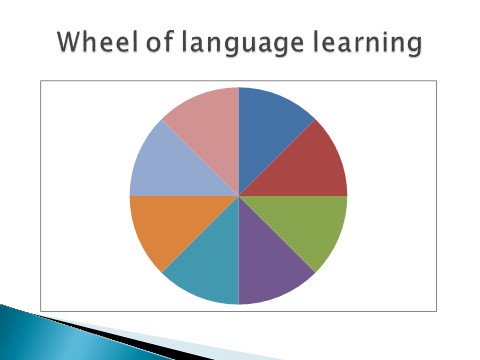
In this exercises students (but also teachers of you use it to identify your life skills) can identify their strengths both linguistic but also so called transferable ones. We can use it in teaching a language but it is a great tool to be used in developing life skills. All students and teachers have certain signature strengths they can fully use in life but very often we are all not aware of them. Sometimes we think that our strengths are very ordinary and they stay outside our awareness. It is called in literature “the taking –strengths for granted effect” (Niemiec, 2013) Another reason for not appreciating our strengths is lack of self-compassion and being very critical towards ourselves. It is often biased by significant others in our life who mainly focus on our weaknesses.
After a student is aware of his strengths and the way they are activated and present in his or her life, the next step is to explore ways to optimise strength use. In order to optimise strength use, it is important to become aware of the potential for growth in a given context. For some strengths, there may be sufficient room and opportunities for using them more frequently and/or more intensely. For
other strengths, certain limitations may prevent the strengths from being used more.
A. Extension possibility
Analysing the wheel you can formulate different questions like:
What do you see when you take a look at the graph?
How would you consider your strengths to be useful in the learning context?
Which strengths can be used more?
Which strengths leave little or no room for expansion?
What could you do to start using your strengths more in the classroom?
It can be a good exercise to move to the next one when students (similarly with teachers) identify their best selves
B. Best self-exercise
This is a good writing opportunity
Ask your students to write a description of their best selves. They might describe their different skills, competences not necessarily connected with language competence.
Using a wheel in the classroom can move you also toward exercises connected with goal setting.
2. Goal setting exercises values awareness
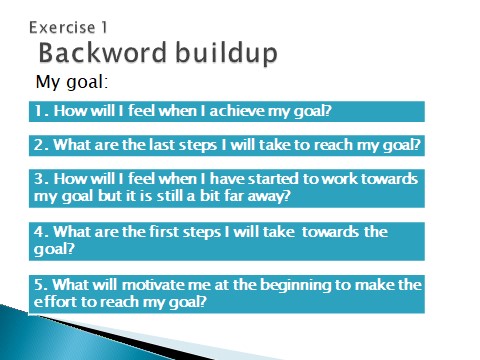
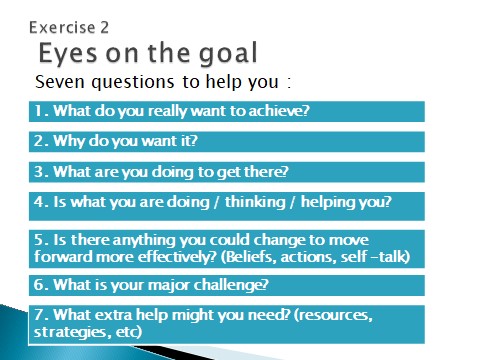
The goal setting exercises make us aware what we really want to achieve and why we want it. It is closely connected to our values which are often defined as the most important things in our life, a system of our beliefs, directions of actions we want to take in our life. Although our values are important we often behave completely inconsistently to them. In times when young people have difficulties with finding real sense in life it seems to be very important for us as teachers to work on their values.
Exercise 3
Write down 4 areas of life which are important for you for example
- Academic achievements
- Relationships with peers
- Friendship
- Family
- Identify your values in each area –write down how you would like it to be in your dream
- Look at them from so called meta position (as a third person) and notice how the life you are living is different from your values. Draw a big circle on the floor and imagine that the centre is the place where your life is fully consistent with your values but the more distant you are from the centre the consistency is lower.
- Place yourself in the space considering each area.
- Now write down the obstacles which don’t allow you to live the life you want. Write down the external and internal factors which might stop you from being consistent with your values
- Think about the actions or even small steps you could take to eliminate the certain obstacles.
3. Hope exercises
Resilience and well- being can be practised through hope exercises
Exercise 1
Visualise your goal ( use all your senses,imagine yourself having the goal attained, hear the voices around you and feel in your body the success)
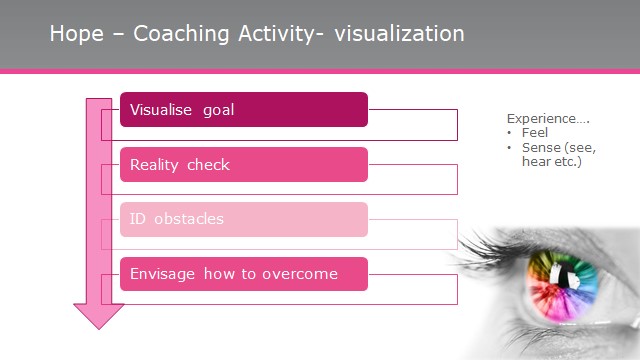
Example:
1. Goal – to speak perfect Spanish
Imagine yourself sitting in pub in Barcelona speaking perfect Spanish
Hear people around you speaking Spanish and hear yourself speaking perfect Spanish
Feel it in your body and mind how it is to be perfect speaker of Spanish
2 Reality check
What is your knowledge of Spanish?
What skills you have, which of your strengths can help you to learn Spanish
3 Obstacles
What are the obstacles or difficulties you encounter which don’t allow you to learn Spanish
4. Envisage how to overcome
Prepare a list of activities you may take to overcome the existing obstacles
Exercise 2
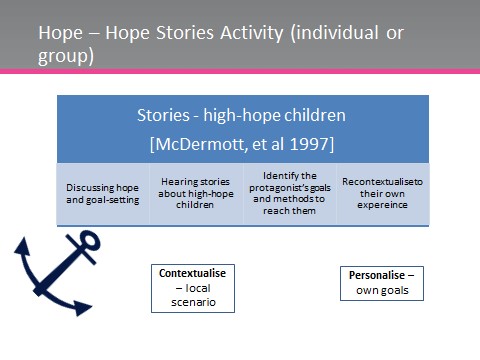
- Students discuss the issue of hope and goal setting
- Listen the stories about high hope children (you can use the book by Matthew Gallagher& Shane J Lopez The Oxford handbook of hope) and think how your students could incorporate hope into their life,
- Students tell their own hope stories and personalise their goals
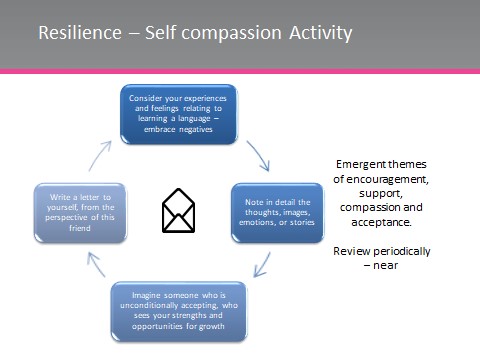
There are many more exercises teachers can apply in the classroom which can enhance well-being and resilience of students. It is also important to remember that teachers need to take care of their own well-being if they want to work effectively with students. Teachers should have am access to coaches or therapists to get proper support. Positive education focuses on evoking positive emotions, relationships and meaningful activities.
References
Biswas-Diener, R. (2010). Practicing Positive Psychology Coaching: Assessment, Activities and Strategies for Success. Malden, MA: John Wiley & Sons.
Clifford, T. (2011). What happens when coachees explore their strengths? International Journal of Evidence Based Coaching and Mentoring, Special Issue No.5, 139-153.
Cohen, S., Doyle, W.J., Turner, R.B., Alper, C.M. and Skoner, D.P. (2003). Emotional style and susceptibility to the common cold. Psychosomatic Medicine, 65(4), 652–7.
Curtis, D.F., & Kelly, L. (2013). Effect of a quality of life coaching intervention on psychological courage and self-determination. International Journal of Evidence Based Coaching and Mentoring, 11(1), 20-38.
Dodge, R., Daly, A.P., Huyton, J. & Sanders L. D. (2012) The challenge of defining wellbeing. International Journal of Wellbeing, 2:3, pp. 222-235.
Deci, E. L., & Ryan, R. M. (1995). Human autonomy: The basis for true self-esteem. In M. H. Kernis (Ed.), Plenum series in social/clinical psychology. Efficacy, agency, and self-esteem (p. 31–49). Plenum Press.
Edwards, S.D.(2005). A psychology of breathing methods. International Journal of Mental Health Promotion, 7 (4), 28-34.
Frisch, M.H. (2001). The emerging role of the internal coach. Consulting Psychology Journal: Practice and Research, 53, 240–250.
Gałązka, A (2018) Building teachers’ psychological resilience and well-being through drama, ICERI2018 Proceedings, 11th International Conference of Education, Research and Innovation November 12th-14th, 2018 — Seville, Spain, ISBN: 978-84-09-05948-5, pages 373-382
Gałązka A, Jarosz J (2019) Life coaching as a remedy in building teachers' psychological resilience and well-being. Edulearn19 Proceedings ISBN:978-84-09-12031-4 ISSN: 340-1117, DOI 1021125/edulearn/2019/0632
Gordon-Bar, S. (2014). How personal systems coaching increases self-efficacy and well-being for Israeli single mothers. International Journal of Evidence Based Coaching and Mentoring, 12(2), 59-73.
Grant, A.M. (2003). The impact of life coaching on goal attainment, metacognition and mental health. Social behavior and personality, 31(3), 253-264.
Green, S., Oades, L.G., & Grant, A.M. (2006). Cognitive-behavioral, solution-focused life coaching: enhancing goal striving, well-being, and hope. The Journal of Positive Psychology, 1(3), 142-149.
Leach, C.J., Green, L.S., & Grant, A. (2011). Flourishing youth provision: the potential role of positive psychology and coaching in enhancing youth services. International Journal of Evidence Based Coaching and Mentoring, 9(1), 44-58.
Lyubomirsky, S. (2006) Happiness: Lessons from a new science. British Journal of Sociology, 57(3), 535–6.
McCallum, F. & Price, D. (2010). Well teachers, well students. Journal of Student Wellbeing, 4(1), 19-34.
Michaels, J. (2010). Life Coaching. American Fitness, 28(5), 24-31.
Michalos, A.C. (2004) Social indicators research and health-related quality of life research. Social Indicators Research, 65(1): 27-72.
Michalos, A.C., Zumbo, B.D., and Hubley, A. (1999) Public services and the quality of life. Social Indicators Research, 48(2): 125-157.
Prescott, T. (2010). Why is Progress a Controversial Issue in Coaching? International Journal of Evidence Based Coaching and Mentoring, Special Issue No.4, 21-36.
Ryff CD, Keyes CLM. (1995). The structure of psychological well-being revisited. Journal of Personality and Social Psychology, 69(4), 719.
Sheldon, K. M., Kasser, T., Smith, K., & Share, T. (2002). Personal goals and psychological growth: Testing an intervention to enhance goal attainment and personality integration. Journal of Personality, 70, 5-31.
Schneider, J.I., Hashizume, J., Heak, S., Maetani, L., Ozaki, R.R., & Watanabe, D.L. (2011). Identifying challenges, goals and strategies for success for people with diabetes through life coaching. Journal of Vocational Rehabilitation, 34(2011), 129-139.
Seligman, M., Steen, T. A., Park, N., & Peterson, C. (2005). Positive psychology progress: Empirical validation of interventions. American Psychologist, 60, 410–21.
Seligman, M, Ernst, R, Gillham, J., Reivich, K. & Linkins, M. (2009). Positive education: positive psychology and classroom interventions. Oxford Review of Education, 35(3), 293-311.
Sin, N.L. and Lyubomirsky, S. (2009) Enhancing well-being and alleviating depressive symptoms with positive psychology interventions: A practice-friendly meta-analysis. Journal of Clinical Psychology, 65(5), 467–87.
Snyder, C.R., Rand, K.L., & Sigmon, D.R. (2002). Hope theory: A member of the positive psychology family. In C. R. Snyder & S. J. Lopez (Eds), Handbook of Positive Psychology (pp. 257–276). London: Oxford University Press.
White, M., & Kern. M. L. (2017). Wellbeing: If you treasure it you will measure it. Independence Journal of the Association of Heads of Independent Schools of Australia, 42(2), 50-54.
White, M. A., & Kern, M. L., (2018). Positive education: Learning and teaching for wellbeing and academic mastery. International Journal of Wellbeing, 8(1), 1-17.
Whitmore, J. (2004). Coaching for performance. London: Nicholas Brealey.
Whitworth, L., Kimsey-House, K., Kimsey-House, H., & Sandahl, P. (2007). Co-Active Coaching: New Skills for Coaching People Toward Success in Work and Life (2nd ed.), California: Davies-Black Publishing.
Please check the NLP and Coaching for the English Classroom course at Pilgrims website.
Please check the Advanced NLP and Coaching for the English Classroom course at Pilgrims website.
Please check the How to Motivate Your Students course at Pilgrims website.
Positive Education and Well-being in the ELT Classroom
Alicja Galazka, PolandPositive Teaching
Joanna Skrzelinska, PolandTeacher-Student Relations in the Modern World
Bozena Janiszewska, PolandThe Three-step Approach to Feedback as a Stress-reduction Tool During the Class Observation Process
Magdalena Kazmierkiewicz, PolandThe Value of Positive Feedback and Ongoing Needs Analysis in the Process of Formative Assessment
Lucyna Wilinkiewicz-Górniak, Poland